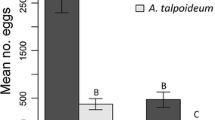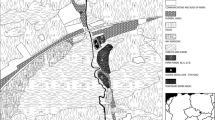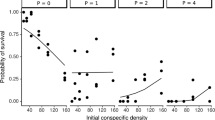Abstract
Natural selection should favor females that avoid ovipositing where risk of predation is high for their progeny. Despite the large consequences of such oviposition behavior for individual fitness, population dynamics, and community structure, relatively few studies have tested for this behavior. Moreover, these studies have rarely assessed the mode of detection of predators, compared responses in prey species that vary in vulnerability to predators, or tested for the behavior in natural habitats. In an outdoor artificial pool experiment, we tested the oviposition responses of two dipteran species, Culiseta longiareolata (mosquito) and Chironomus riparius (midge), to the hemipteran predator, Notonecta maculata. Both dipteran species have similar life history characteristics, but Culiseta longiareolata larvae are highly vulnerable to predation by Notonecta, while Chironomus riparius larvae are not. As their vulnerabilities would suggest, Culiseta longiareolata, but not Chironomus riparius, strongly avoided ovipositing in pools containing Notonecta. An experiment in natural rock pools assessing oviposition by Culiseta longiareolata in response to Notonecta maculata yielded an oviposition pattern highly consistent with that of the artificial pool experiment. We also demonstrated that the cue for oviposition avoidance by Culiseta longiareolata was a predator-released chemical: Notonecta water (without Notonecta replenishment) repelled oviposition for 8 days. Oviposition avoidance and mode of detection of the predator have important implications for how to assess the true impact of predators and for the use of commercially produced kairomones for mosquito control.


Similar content being viewed by others
References
Angelon KA, Petranka JW (2002) Chemicals of predatory mosquitofish (Gambusia affinis) influence selection of oviposition site by Culex mosquitoes. J Chem Ecol 28:797–806
Armitage PD, Cranston PS, Pinder LCV (1995) The Chironomidae: biology and ecology of non-biting midges. Chapman and Hall, London
Bentley MD, Day JF (1989) Chemical ecology and behavioral aspects of mosquito oviposition. Annu Rev Entomol 34:401–421
Berendonck TU (1999) Influence of fish kairomones on the ovipositing behavior of Chaoborus imagines. Limnol Oceanogr 44:454–458
Berendonk TU, Bonsall MB (2002) The phantom midge and a comparison of metapopulation structures. Ecology 83:116–128
Binckley CA, Resetarits WJ Jr (2002) Reproductive decisions under threat of predation: squirrel treefrog (Hyla squirella) responses to banded sunfish (Enneacanthus obesus). Oecologia 130:157–161
Binckley CA, Resetarits WJ Jr (2003) Functional equivalence of non-lethal effects: generalized fish avoidance determines distribution of the gray treefrog, Hyla chrysoscelis, larvae. Oikos 102:623–629
Blaustein L (1998) Influence of the predatory backswimmer, Notonecta maculata, on invertebrate community structure. Ecol Entomol 23:246–252
Blaustein L (1999) Oviposition site selection in response to risk of predation: evidence from aquatic habitats and consequences for population dynamics and community structure. In: Wasser SP (ed) Evolutionary theory and processes: modern perspectives. Kluwer, Dordrecht, pp441–456
Blaustein L, Margalit J (1994) Mosquito larvae (Culiseta longiareolata) compete with and prey upon toad (Bufo viridis) immatures. J Anim Ecol 63:841–850
Blaustein L, Margalit J (1995) Spatial distributions of Culiseta longiareolata and Bufo viridis within and among desert pools. J Arid Environ 29:199–211
Blaustein L, Margalit J (1996) Priority effects in temporary pools: nature and outcome of mosquito larva-toad tadpole interactions depend on order of entrance. J Anim Ecol 65:77–84
Blaustein L, Schwartz SS (2001) Why study ecology in temporary pools? Isr J Zool 47:303–312
Blaustein L, Kotler BP, Ward D (1995) Direct and indirect effects of a predatory backswimmer (Notonecta maculata) on community structure of desert temporary pools. Ecol Entomol 20:311–318
Briers RA, Warren PH (2000) Population turnover and habitat dynamics in Notonecta (Hemiptera: Notonectidae) metapopulations. Oecologia 123:216–222
Chesson J (1984) Effect of notonectids (Hemiptera: Notonectidae) on mosquitoes (Diptera: Culicidae): predation or selective oviposition? Environ Entomol 13:531–538
Chivers DP, Smith RJF (1998) Chemical alarm signaling in aquatic predator/prey interactions: a review and prospectus. Ecoscience 5:338–352
Dicke M, Grostal P (2001) Chemical detection of natural enemies by arthropods: an ecological perspective. Annu Rev Ecol Syst 32:1–23
Dodson SI, Crowl TA, Peckarsky BL, Kats LB, Covich AP, Culp JM (1994) Nonvisual communication in fresh-water benthos—an overview. J N Am Benth Soc 13:268–282
Eitam A, Blaustein L, Mangel M (2002) Effects of Anisops sardea (Hemiptera: Notonectidae) on oviposition habitat selection by mosquitoes and other dipterans and on community structure in artificial ponds. Hydrobiologia 485:183–189
Elert E von, Pohnert G (2000) Predator specificity of kairomones in diel vertical migration of Daphnia: a chemical approach. Oikos 88:119–128
Grostal P, Dicke M (1999) Direct and indirect cues of predation risk influence behavior and reproduction of prey: a case for acarine interactions. Behav Ecol 10:422–427
Hopey ME, Petranka JW (1994) Restriction of wood frogs to fish-free habitats—how important is adult choice. Copeia 4:1023–1025
Kats LB, Dill LM (1998) The scent of death: chemosensory assessment of predation risk by prey animals. Ecoscience 5:361–394
Kiflawi M, Blaustein L, Mangel M (2003a) Oviposition habitat selection in a mosquito, Culiseta longiareolata in response to risk of predation and conspecific density. Ecol Entomol 28:168–173
Kiflawi M, Blaustein L, Mangel M (2003b) Predation-dependent oviposition habitat selection by the mosquito Culiseta longiareolata: a test of competing hypotheses. Ecol Lett 6:35–40
Laurila A, Aho T (1997) Do female common frogs choose their breeding habitat to avoid predation on tadpoles? Oikos 78:585–591
Laurila A, Kujasalo J, Ranta E (1998) Predator-induced changes in life history in two anuran tadpoles: effects of predator diet. Oikos 83:307–317
Marsh DM, Borrell BJ (2001) Flexible oviposition strategies in tungara frogs and their implications for tadpoles spatial distributions. Oikos 93:101–109
McCall PJ (2002) Chemoecology of oviposition in insects of medical and veterinary importance. In: Hilker M, Meiners T (eds) Chemoecology of insect eggs and egg deposition. Blackwell, Berlin, pp 265–290
Morin PJ (1998) Realism, precision, and generality in experimental ecology. In: Resetarits WJ, Bernardo J (eds) Experimental ecology: issues and perspectives. Oxford University Press, Oxford
Petranka J, Hayes L (1998) Chemically mediated avoidance of a predatory odonate (Anax junius) by American toad (Bufo americanus) and wood frog (Rana sylvatica) tadpoles. Behav Ecol Sociobiol 42:263–271
Resetarits WJ (2001) Colonization under threat of predation: avoidance of fish by an aquatic beetle, Tropisternus lateralis (Coleoptera : Hydrophilidae). Oecologia 129:155–160
Resetarits WJ, Wilbur HM (1989) Choice of oviposition site by Hyla chrysoscelis—role of predators and competitors. Ecology 70:220–228
Service MW (1993) Mosquito ecology: field sampling methods, 2nd edn. Elsevier, Amsterdam
Skelly DK (2001) Distribution of pond-breeding anurans: an overview of mechanisms. Isr J Zool 47:313–332
Skelly DK (2002) Experimental venue and estimation of interaction strength. Ecology 83:2097–2101
Skelly DK, Kiesecker JM (2001) Venue and outcome in ecological experiments: manipulations of larval anurans. Oikos 94:198–208
Sokal RR, Rohlf FJ (1995) Biometry: the principles and practice of statistics in biological research, 3rd edn. Freeman, New York
Speiler M, Linsenmair KE (1997) Choice of optimal oviposition sites by Hoplobatrachus occipitalis (Anura: Ranidae) in an unpredictable and patchy environment. Oecologia 109:184–199
Spencer M, Blaustein L, Cohen JE (2002) Oviposition habitat selection by mosquitoes (Culiseta longiareolata) and consequences for population size. Ecology 83:669–679
Stav G, Blaustein L, Margalith Y (2000) Influence of nymphal Anax imperator (Odonata: Aeshnidae) on oviposition by the mosquito Culiseta longiareolata (Diptera: Culicidae) and temporary pool community structure. J Vector Ecol 25:190-202
Tietze NS, Mulla MS (1991) Biological control of Culex mosquitoes (Diptera: Culicidae) by the tadpole shrimp Triops longicaudatus (Notostraca, Triopsidae). J Med Entomol 28:24–31
Turner AM, Montgomery SL (2003) Spatial and temporal scales of predator avoidance experiments with fish and snails. Ecology 84:616–622
Ward D, Blaustein L (1994) The overriding influence of flash floods on species:area curves in ephemeral Negev desert pools: a consideration of the value of island biogeography theory. J Biogeogr 21:595–603
Wilbur HM (1997) Experimental ecology of food webs: complex systems in temporary ponds. Ecology 78:2279–2302
Wisenden BD (2000) Scents of danger: the evolution of olfactory ornamentation in chemically-mediated predator-prey interactions. In: Espmark Y, Amundsen T, Rosenqvist G (eds) Animal signals: signaling and signal design in animal communication. Tapir Academic Press, Trondheim, Norway, pp365–386
Wisenden BD, Millard MC (2001) Aquatic flatworms use chemical cues from injured conspecifics to assess predation risk and to associate risk with novel cues. Anim Behav 62:761–766
Wisenden BD, Chivers DP, Brown GE, Smith RJF (1995) The role of experience in risk assessment: avoidance of areas chemically labeled with fathead minnow alarm pheromone by conspecifics and heterospecifics. Ecoscience 2:116–122
Acknowledgements
We thank John Marten for taxonomic help, Yakub Maclade, Eden Orion, and Avinoam Luria for logistical support, and Matthew Spencer, Brian Wisenden, Andrew Taggi, and Jerrold Meinwald for valuable discussion. Anonymous reviewer comments lead to a greatly improved manuscript. The study was supported by US-Israel Binational Science Foundation Grant No. 98-390 awarded to L.B. and MM and Israel Science Foundation Grant 600/02 awarded to L.B. J.E.C. acknowledges with thanks the support of US National Science Foundation grant DEB 9981552 and the hospitality of Mr. and Mrs. William T. Golden during this work.
Author information
Authors and Affiliations
Corresponding author
Rights and permissions
About this article
Cite this article
Blaustein, L., Kiflawi, M., Eitam, A. et al. Oviposition habitat selection in response to risk of predation in temporary pools: mode of detection and consistency across experimental venue. Oecologia 138, 300–305 (2004). https://doi.org/10.1007/s00442-003-1398-x
Received:
Accepted:
Published:
Issue Date:
DOI: https://doi.org/10.1007/s00442-003-1398-x




